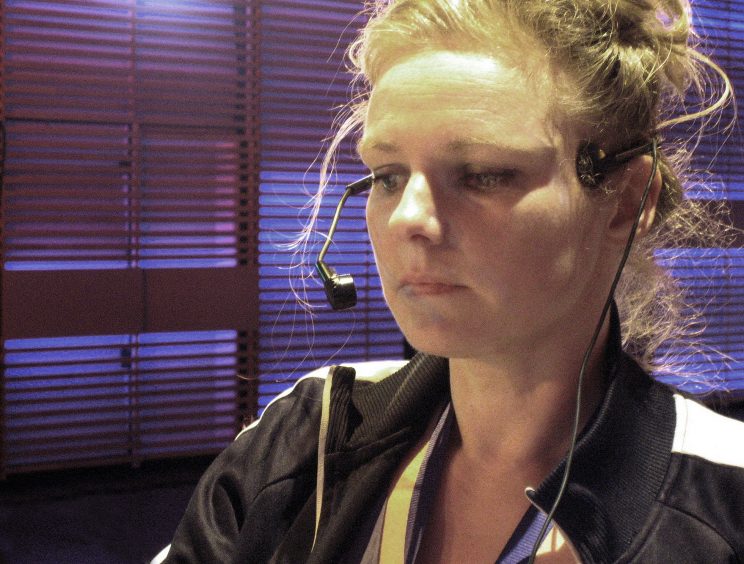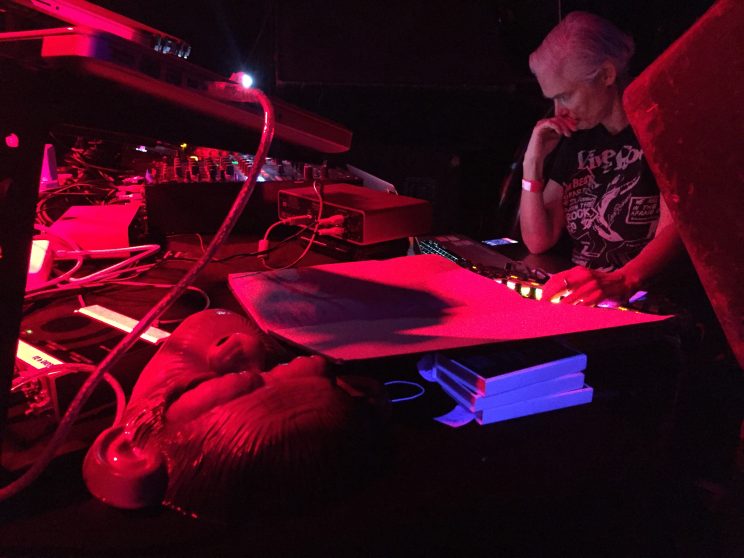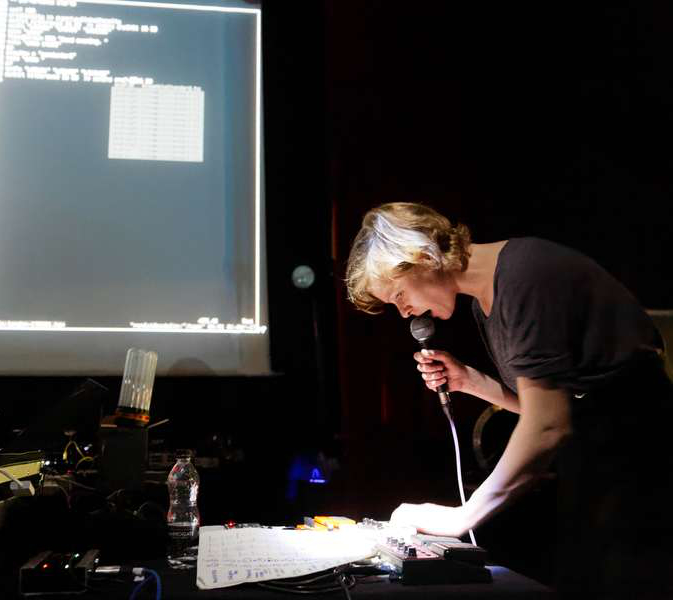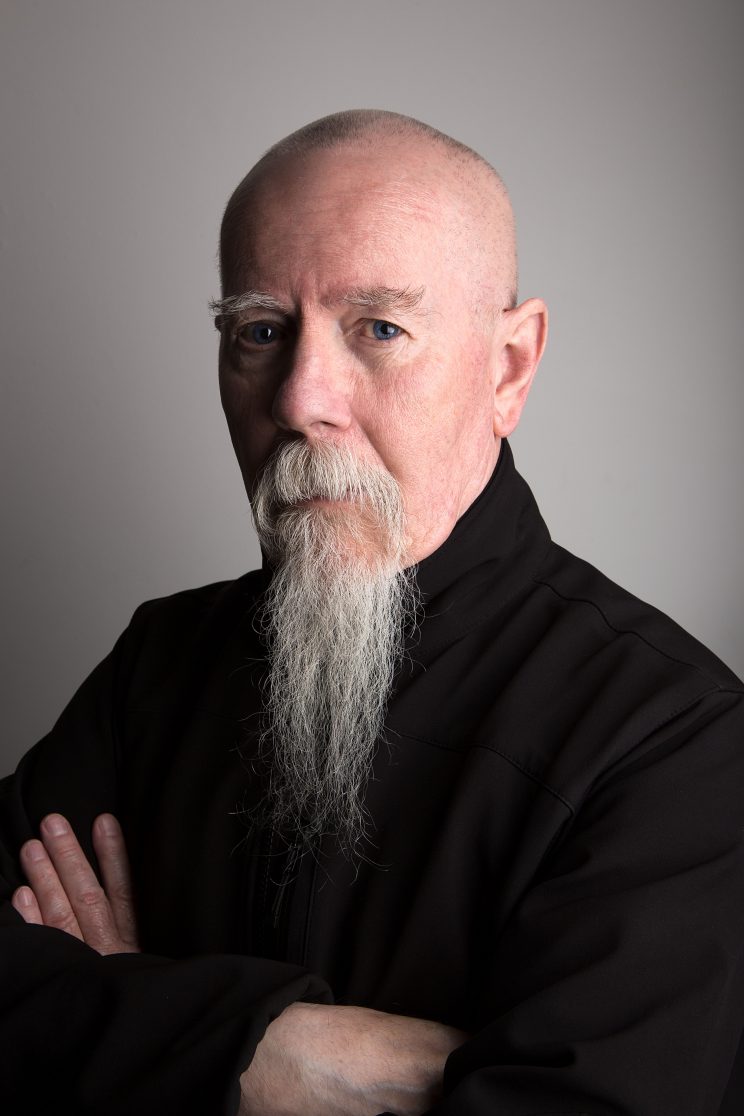IKLECTIK presents,
</coding in GE> : Corpora Aliena – ‘The Digital Voice’.
Saturday 17 November doors 7.30pm | £8 adv / £10 door | BUY TICKETS
Corpora Aliena is pleased to present a concert of diverse experimental music performances based on the theme of
‘The Digital Voice’.
Included in the programme are;
Iris Garrelfs – who will give an improvised performance using voice with electronics; the composer Liz Helman will be performing a new work ‘From the Street’ – a soundscape of voice and place that was produced using processed field recordings and sounds from the urban environment; Steph Horak will be exploring the boundary between natural voice and digital processing using a bespoke system of hardware and self-made software; and Bernhard Living will give a live performance of his digitally-based composition ‘Ich tanze nicht’.
In addition to the live performances, there will be a screening of a film MMXVIII (2018, video, 25’) by the German producer Patrick Stevens (aka Hypnoskull) that have curated by Dasha Birukova.
MMXVIII
The film consists of several scenes which carry the name of the geographic places they were shot. In general, there is no chosen order to the scenes, as they appear in a chronological way – being the moment they were captured. The camera becomes the tool to portray time as such, not the event which folds out in front. In a certain way, MMXVIIIbears Influences by both the anarchic oriented visual style of f.e. subcultures like the 80-es skateboarding scene, as well as the photography of artists like Dirk Braeckman or the cinematography of Chantal Akerman, to name only a few. There are no narrative elements in whatsoever traditional way – the main narrator becomes ‘sound’. MMXVIII blends the pure and essential black and white images with a mainly alienated sound. Partly the original sound of the shots is mixed with spoken word, either quotes or parts from stories and/or books which were read by Patrick Stevens during the period the actual shot was made, partly own written biographical texts or thoughts, reflecting about the moment the shot was made. All the sounds are either source materials from the filming, or the voice of Patrick Stevens. There are no ‘external’ sound sources, synthesis, machines, whatsoever, that brings tricky idea of “nature” pretended to be digital.
It would be an easy thing to call MMXVIII a sort of ‘diary’, as such it rather forms a sketchbook. Everyone loves sketchbooks, as they reveal a process. As you can notice and see the doubts of the person who wrote, drew, sketched inside. In audiovisual art and mainly film this is a more uncommon approach – MMXVIII partly follows this sketchbook approach to generate a total atmosphere.
The Digital Voice concert is an exciting opportunity to see and hear some of the leading musicians and artists who are a part of the contemporary experimental music scene.

Dasha Birukova
Dasha Birukova (b. 1985 Russia) is a curator and writer based in Lisbon. She graduated from the Russian State University for the Humanities, Moscow, Russia, art history department and at the Russian State University of Cinematography (VGIK), Moscow, Russia, cinema history department. Her specialisms are experimental film, video and media art,
Birukova curated the “New Media” programme at the National Centre for Contemporary Arts (Moscow) and co-curated the Festival of Media Art “VideoFocus” organized by NCCA(2014 and 2015).
She was a co-curator of the exhibition “Error Message” that was part of the 4th Moscow International Biennale of Young Art, 2014.
In 2016, Birukova joined the team of the high-profile project “Geometry of Now” curated by British artist Mark Fell, organized by the VAC Foundation in Moscow.
In 2017, she curated the exhibition “Pink Flamingos” at the art space BLEEK in Belgium.
In 2018, Birukova was a lecturer at The Russian State University for the Humanities, Moscow, Russia, Department of the art history and at the British Higher School of Art and Design, Moscow, where she curated the exhibition «BRITANKA_coop: ritual», special project of 6th Biennale for Young Art, Winzavod, Moscow.

Iris Garrelfs
Iris Garrelfs is an artist working on the cusp of music, art and sociology. Her practice includes fixed media, installation, improvised performance and has been included in major institutions worldwide, for example Tate Britain, National Gallery, Barbican, Onassis Centre Athens, Visiones Sonores Mexico, Gaudeamus Amsterdam, MC Gallery New York.
Elsewhere she is the commissioning editor of the online journal Reflections on Process in Sound and the co-curator and director of Sprawl, a London based experimental music organisation. Iris has a PhD in Sound Art from University of the Arts London and is senior Lecturer in Sonic Art at Goldsmiths, University of London.
Working with site
Iris Garrelfs is interested in modes of listening as a way of connecting to the world, exploring interrelatedness, patterns and interaction through performances, mixed media projects, and recordings. As a result she focuses on working with site. However, her approach to site-specificity does not mean work is created for a particular locale, nor does the work represent a place, but rather, it is a response to it. She includes people in my understanding of place, people who, through their ideas or presence, participate in creating it. And so Iris’ responses are not an investigation of the geographical, historic or sociological aspects of site, but rather, it is a poetic evocation of presence on the one hand and presence within a space or situation on the other.
Improvised voice
Iris Garrelfs is a composer/performer intrigued by change, fascinated with voices and definitely enamoured by technology. As one of the pioneers of digitally augmented vocal performance, Iris often uses her voice as raw material, which she transmutes into machine noises, choral works or pulverised “into granules of electroacoustic babble and glitch, generating animated dialogues between innate human expressiveness and the overt artifice of digital processing” as the Wire Magzine put it.
Described as the Diamanda Galas of Glitch by BBC3, Iris’ training into creating through voice began very early on. Her parents sang in the village choir, and would often practice at home with Iris making up new melodies, 2nd and 3rd voices to whatever was being sung. She got into the attractions of technology as a teenager, stumbling across her dad’s pulp si-fi magazines. Iris is still waiting for an implant that will siphon off her sonic nerve impulses, fragments of melody, rhythm and correlation floating around in her body and brain. A vital part of her work, be it using voice or other sound material, is improvisation and the use of random elements, the ephemeral fragility and risk implied in giving up control to the moment, a sonic singularity moving through space.
Moulding complex sonic or multi-sensorial collages, her work has been compared to artists such as Yoko Ono, Henri Chopin, Joan La Barbara, Meredith Monk and Arvo Part. Pieces and performances have featured in exhibitions, festivals and as part of residencies internationally, including International Computer Music Conference (NY, 2010), GSK Contemporary at the Royal Academy Of Arts (London 2008/09), Gaudeamus Live Electronics Festival, (Amsterdam 2007), and Visiones Sonoras (Mexico 2006).
Iris works solo as well as in collaboration with other artists, for example with Thomas Koner in his Futurist Manifest, Robert Lippok (To Rococo Rot),Kaffe Matthews, Scanner, Si-cut.db, the improvising group Symbiosis Orchestra, or artist collective Urbania.

Liz Helman
Liz Helman was born in London, England, where she continues to live and work. She is self-taught and with no formal training as a composer.
Her current album, Daylight Dreaming, is available on Montreal label, Kohlenstoff Records
http://kohlenstoff.ca/album/daylight-dreaming
As a multi-disciplinary artist, Helman has always had an interest in ambient music and sound art as a form of expression. Her work, both visual and sonic, is a response to place and environment. Sensitive to how these energies make her feel, she is interested in the subliminal and sonic exploration of these experiences. By walking the streets, and experiencing different levels of sounds, layers and textures she always begins her process with field recordings before studio intervention. She very much likes working experimentally, following the thread of the sound to its ultimate destination, which she likes to think of as sonic alchemy.
She signed to Kohlenstoff Records, a Montreal-based label and arts-collective in 2015 – and has performed internationally, including a short residency in 2017 with Irena Tomazin as part of ZVO.ČI.TI so.und.ing DUO, CONA | institute for contemporary arts processing, Ljubjlana, Slovenia. Sound pieces have been heard at New York City Electroacoustic Music Festival 2014 and video works have been shown in London and abroad including: MUSLAB Festival, Mexico, 2014; Millenium Film Workshop, New York, 2014; LAB Film Festival at Hackney Wicked, London 2014; Bermuda Triangle Test Engineers benefit for Resonance FM, 2014; LOOP Video Festival, Barcelona 2011; Lesbian & Gay Film Festival, part of festival shorts with Barbara Hammer, BFI, London, 2011; FrinGe Film Fest 2011; Wunderland at tactileBosch, Cardiff 2011; Supermarket Stockholm Art Fair 2011; Whitechapel Gallery Open Screenings, 2010; Rich Mix Cultural Centre, London, UK, 10; Counted Weekend Festival, Roundhouse, London, 2010; Portobello Film Festival 2008; Visions in the Nunnery, Bow Arts Trust 2008; WAVE [Hybridity, Identity & the Self] – Ewha Arts Center, M-Post Gallery, Seoul, Korea, 2006.
Independent curation projects include Facing You, a photography exhibition for Fringe! – Gay Film Festival, 2012; Roma London in 2010; Before.After.Now – Visions of Iraq – a show on Iraqi Art Deluxe Gallery, Hoxton, London 2003. And under the banner of [noplaceprojects*], the exhibitions RePlace in 2009 and no place in 2008. She also has appeared as an Andy Warhol in Yason Banal’s installation piece, Last Warhol Stand Inn at Tate Modern’s 10th Anniversary Festival of Independents in 2010.
http://kohlenstoff.ca/album/daylight-dreaming

Steph Horak
Steph Horak is a sound and video artist. As a vocalist/producer she experiments with different systems for voice and composition, whether through the use of self-programmed systems, or combinations of hardware and electronic instruments built by friends. These experiments can be found under the moniker SheIsRevolting. Stylistically they edge somewhere between experimental electronica, traditional songwriting, and conceptual pieces. Recent sound projects include threehundredandsixtysix, where Horak sings a note a day for a year. These recordings are available on the Fractal Meat Cuts cassette label here: https://fractalmeat.bandcamp.com/album/threehundredandsixtysix and as a digital download here: https://sheisrevolting.bandcamp.com/releases.
Through her video installations Horak reframes mundane and common experiences in hypnotic settings, such as in Commutations I and II which are explorations of the urban environment and transportation systems in London comprised of some 70 videos filmed out of bus (Commutations I) and train (Commutations II) windows. The films are presented in triptych on loop with soundtracks in part comprised from the videos native sound.
Her photographic series Manscapes is a reflection of the traces of man in the seemingly barren landscapes of Iceland. She conducts ongoing light experiments for her Still Life series.
Horak has worked in the field of contemporary electro-acoustic and academic music, project management and exhibition production. She has produced exhibitions for artist Patrick Tresset at Pompidou Centre, (Paris), Merge Festival (with Tate Modern), and Ars Electronica (Linz). She produced the 14th International Conference on New Interfaces for Musical Expression, the Creative Machine Exhibition. As a community arts practitioner she worked with seldom-heard and hard to reach groups across London in therapeutic music, art, and social contexts.
contact: stephhorak@gmail.com
music: http://soundcloud.com/sheisrevolting
other: http://noisevagina.tumblr.com
other: https://soundcloud.com/threehundredandsixtysix

Bernhard Living
Bernhard Living is an experimental music composer, curator and former multi-instrumentalist (playing alto saxophone, bass clarinet snd flute). He was born in Ely, Cambridgeshire, England – and lives and works in London and Southampton. He studied composition with the South African-born composer professor Stanley Glasser at Goldsmiths College, University of London, and philosophy under professors Jonathan Reé and Peter Dews at Middlesex University, London.
Musician
As an international musician (1966 – 1992), Living performed with a number of leading composers and musical innovators, including; Karlheinz Stockhausen, Cornelius Cardew, Hugh Davies, Barry Guy and Mike Westbrook. He is a featured soloist on a number of classic jazz, punk and rock albums, including; Mike Westbrook’s Celebration (1967), Release (1968), and Marching Song (1969); Manfred Mann’s Chapter Three (1969) and Chapter Three Volume Two (1970); Barry Guy’s Ode (1972); and Linder Stirling’s Ludus project (1982). The Sunday Times music critic Derek Jewell described Living’s performance style and technique as ‘revolutionary’. He has also given public performances of compositions from the twentieth-century flute repertoire, including; Luciano Berio “Sequenza”, Pierre Boulez “Sonatine for Flute”, John Cage flute-only versions of “Concert for Piano and Orchestra”, “Atlas Eclipticalis”, “Variations I, II, III, IV, V”, Karlheinz Stockhausen “Aus den Sieben Tagen”, “Musik für Flöte”, “In Freundschaft”; and Edgard Varèse “Density 21.5”.
Curator
In the role of curator (1993 – 2000), Living was influential in setting up the BN1 project, a Brighton-based autonomous arts organisation. Described as a ‘museum without walls’, BN1 commissioned leading digital and installation artists, including Susan Collins, Tessa Elliott, Anna Heinrich & Leon Palmer, Thomas Köner, Simon Poulter, Michael Petry and Paul Sermon, to produce artworks for both traditional exhibition spaces and for the pubic domain. He has been an active advocate of digital technology, and within this role he has sat on a number of advisory boards, including the Arts Council of England and South East Arts, to help shape policy within the arts and their relationship to new media.
Corpora Aliena (2017 – )
In 2017, Living established a new curatorial project, Corpora Aliena. The aims of the projects are to; to present live experimental music events, film screenings and gallery-based projects; to work with artists from the international community – and to develop ‘creative conduits’ between London and other European cities; to create opportunities for young and emerging composers, musicians, artists and experimental film makers; and to ensure that there is a positive gender balance – and to have a high proportion of female composers and musicians taking part in all of Corpora Aliena’s events.
Composer
Bernhard Living’s digitally-based compositions have taken minimalistic compositional techniques to what he considers to be their logical conclusion, with his music being characterised by sparse textures, long periods of silence, maximal repetition and minimal variation. The compositions are often devoid of musical elements such as melody, harmony and rhythm, and as an alternative they explore the use of sound colour and sonic textures.
Influences for Living’s work range from the historical avant-garde, including John Cage, Karlheinz Stockhausen, Edgard Varèse; the Russian avant-garde, Kazimir Malevich, Olga Rozanova and Liubov Popova; American jazz; John Coltrane, Eric Dolphy, Ornette Coleman and Albert Ayler; American abstract expression and colour-field painting, Mark Rothko, Barnett Newman and Morris Louis; American minimal art, Agnes Martin, Donald Judd and Carl Andre; to contemporary loop-based dance music, particularly techno. In many ways, his music could be considered as an evolved non-dance form of techno, but one that exists within a different cultural context and along a different time continuum.
Bernhard Living’s complete musical output can be found at Bandcamp
Links
Bernhard Living
http://www.bernhard-living.net/index.html
Bandcamp
https://bernhardliving.bandcamp.com
FaceBook Artist’s Page
https://www.facebook.com/pages/Bernhard-Living/189547757734088
Vimeo
https://vimeo.com/bernhardliving
Recent Performances
‘Violin Stories’ and ‘Pure Presence’, Poetronica, Moscow 20.04 and 21.04.2018
‘The Mysteries of Concrete’ Iklectik, London 24.03.2018
‘Black T-Shirt’ Iklectik, London 22.10.2017
https://www.facebook.com/events/1301639886625771/
https://iklectikartlab.com/durrant-thompson-living-gagarin/
‘The Mysteries of Concrete’, Poetronica, Moscow 15.12.2016
https://www.facebook.com/events/212683032506629/
https://www.facebook.com/events/224560104635834/
http://www.bernhard-living.net/index.html

Patrick Stevens (Hypnoskull)
Patrick Stevens (°1973) (B/G) started an industrial noise project called hypnoskull in 1992 which later would turn the direction into one of the leading rhythmical noise/industrial techno projects of the infamous German label ant-zen records. He was also a founding member of the early Sonar project together with Dirk Ivens (The Klinik, Absolute Body Control). A number of former side projects include Noshinto (on the Belgian cult techno label Kk Records), Sliding Elements, Reset, <C:F>, Sona Eact®,… An extensive discography can be found at discogs. One of the old side projects named 33mhz is still in use and captures his sound design work for film.
Audiovisual workNext to Hypnoskull, also active in the art scene making audio installations and active as a cinematographer for art house film- and documentary productions.
EducationGraduated in 1996 in Belgium as a journalist with a thesis work and curatorship of a one-week festival and exhibition about ‘unstable media – the use of new media in art’.
Personal/thematics Half German, half Belgian – born in the cold war, facing both the legacy of countries that were bearing the guilt for one of the biggest tragedies in human history, and of a country that was on the side of the victims. This duality is not a negative point to start, but opens all gates for a deeper understanding of the mechanisms that cause unexplainable injustice, evil and tragedy – in order to be able to refuse these mechanisms on a personal level. Close to 99% of the thematics come from this starting point and always end up questioning every ‘rule’, order or law instead of taking it all for granted.
https://www.facebook.com/therealhypnoskull/
https://www.facebook.com/allhypnotic


